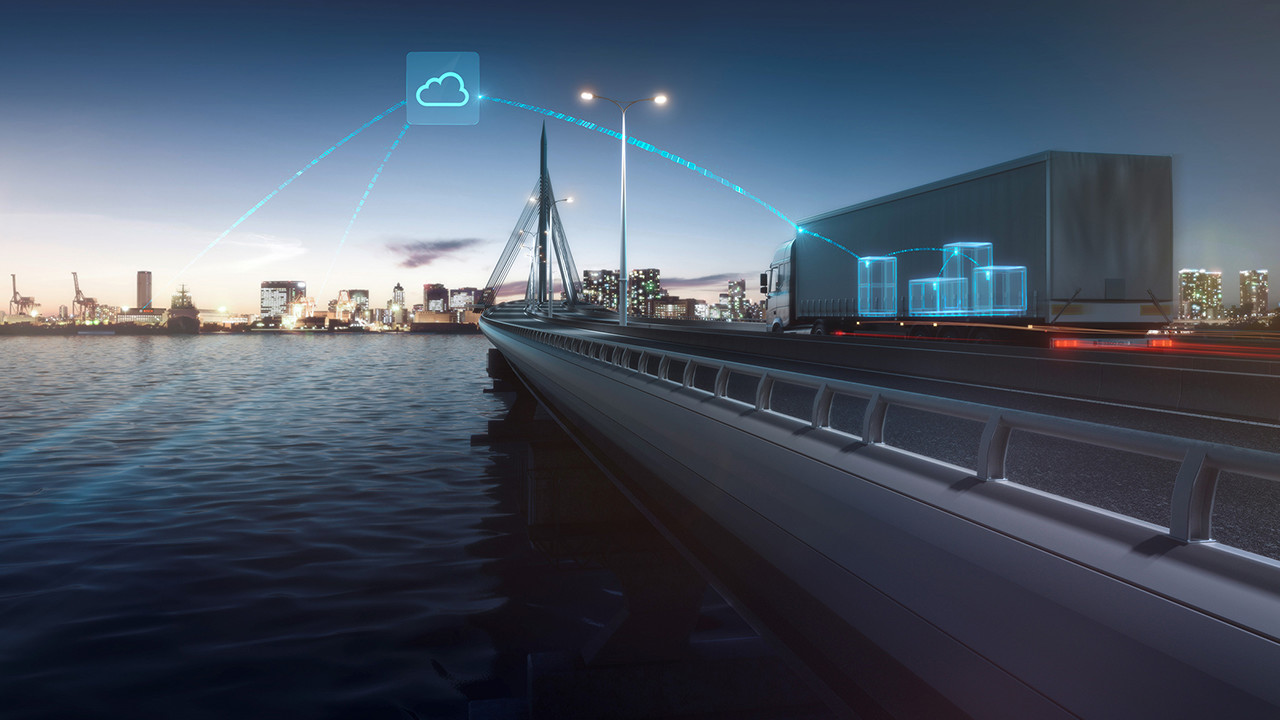Among the future mobility developments on show at Bosch Mobility Experience 2017, one of the greatest stars – and certainly the biggest – was the 40-tonne VisionX smart truck. This eye-catching, streamlined monster embodies Bosch’s conception of the future of commercial vehicles and road cargo transport. This rests on three technological pillars: connectedness, electromobility and self-driving, autonomous technology.
In future, a combination of driver assistance systems and automation will make trucks safer and more reliable. The truck of the future will almost run on rails, even taking over some driving functions. For example, when it goes on to the motorway, the vehicle will be able to join a convoy – like a cargo train, but made up of a series of trucks. The lead truck will be electronically-connected to the others following it, and maintain constant communication with them. To enable members of the convoy to accelerate, brake and manoeuvre in sync, automated driving is being raised to a completely new level, resulting in improved safety and less of a burden for drivers.
The driver has complete control of the truck until he goes on to the motorway and gets identifier data from a suitable convoy. The driver plans his subsequent route and still maintains overall control after joining the convoy. He has access to all of the vital information through a screen in the cabin and can take the wheel again whenever necessary. The same is true when a truck leaves the convoy and exits the motorway. At that point, the driver takes back control and continues his journey manually or semi-automatically.
Greater efficiency through hybrid technology and convoys
The Bosch VisionX concept starts out with the diesel engine – which is particularly economical for transporting heavy loads by road – combined with driver assistance systems involving hydraulic pumps and electric motors.
In addition to this hybrid technology, future trucks will benefit from transport in convoy: these include improved safety through coordinated braking, acceleration and steering, and much greater economy of operation. Travelling in the slipstream can save 10% of fuel costs, a major competitive advantage in the commercial vehicle industry and for companies operating large fleets.
VisonX, link in the connected logistics chain
As an intelligent connected device, the truck of the future will become a key element in international logistics: the new Bosch systems will make drivers’ lives easier in many ways, from receipt of carriage documents and goods uplift to automation of the manoeuvres the vehicle must make when it reaches the destination.
Vehicles get all the data they need, in real time, from the Bosch IoT cloud. That includes routing information, traffic congestion, diversions and unloading constraints at the destination. With access to the Bosch IoT cloud, hauliers and customers can also follow the route and current position of the goods and of their goods at any time. Drivers will be able to search for parking places along the route and book them in advance, making travel easier and less stressful.
Minimum downtime, predictive maintenance
Fuel consumption is a key factor in operating costs, but there are others, such as losses from standing vehicles. The Bosch VisionX concept vehicle also shows the potential for optimisation in this area.
Predictive maintenance, for example, tracks the technical state of the truck and warns the haulier or operator to carry out maintenance and repairs at the right times. This is the best way of planning the truck’s downtime, minimizing lost working time and further enhancing haulage and fleet efficiency.
Mónika Hack
+36 70 510 5516
Mobility Solutions is the largest Bosch Group business sector. In 2016, its sales came to 43.9 billion euros, or 60 percent of total group sales. This makes the Bosch Group one of the leading automotive suppliers. The Mobility Solutions business sector combines the group’s expertise in three mobility domains – automation, electrification, and connectivity – and offers its customers integrated mobility solutions. Its main areas of activity are injection technology and powertrain peripherals for internal-combustion engines, diverse solutions for powertrain electrification, vehicle safety systems, driver-assistance and automated functions, technology for user-friendly infotainment as well as vehicle-to-vehicle and vehicle-to-infrastructure communication, repair-shop concepts, and technology and services for the automotive aftermarket. Bosch is synonymous with important automotive innovations, such as electronic engine management, the ESP® anti-skid system, and common-rail diesel technology.
The Bosch Group is a leading global supplier of technology and services. It employs roughly 390,000 associates worldwide (as of December 31, 2016). The company generated sales of 73.1 billion euros in 2016. Its operations are divided into four business sectors: Mobility Solutions, Industrial Technology, Consumer Goods, and Energy and Building Technology. As a leading IoT company, Bosch offers innovative solutions for smart homes, smart cities, connected mobility, and connected manufacturing. It uses its expertise in sensor technology, software, and services, as well as its own IoT cloud, to offer its customers connected, cross-domain solutions from a single source. The Bosch Group’s strategic objective is to deliver innovations for a connected life. Bosch improves quality of life worldwide with products and services that are innovative and spark enthusiasm. In short, Bosch creates technology that is “Invented for life.” The Bosch Group comprises Robert Bosch GmbH and its roughly 440 subsidiaries and regional companies in some 60 countries. Including sales and service partners, Bosch’s global manufacturing and sales network covers nearly every country in the world. The basis for the company’s future growth is its innovative strength. At 120 locations across the globe, Bosch employs some 59,000 associates in research and development.
Additional information is available online at www.bosch.com, www.iot.bosch.com, www.bosch-press.com, www.twitter.com/BoschPresse, www.bosch.hu






